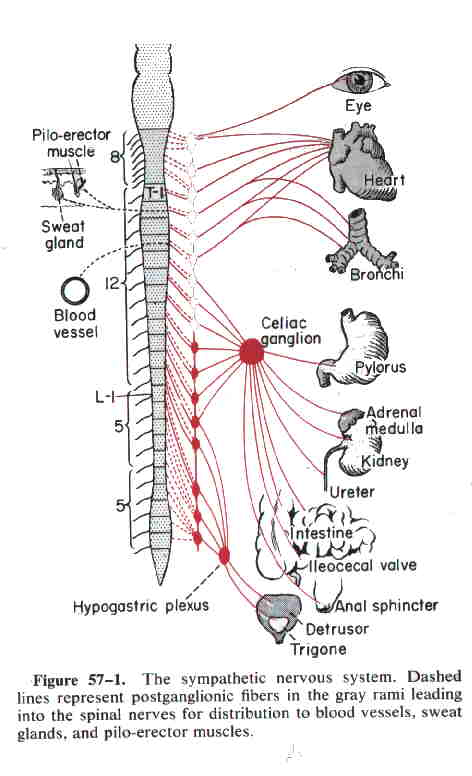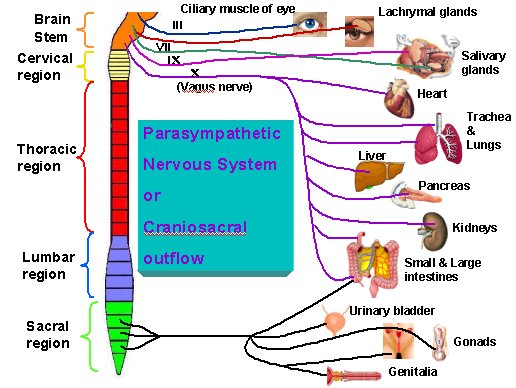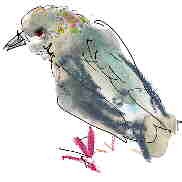Norman
Allan | ||||
|
| |
the Sympathetic Nervous System the Parasympathetic Nervous System the balance between them the lack of balance "Vagotomies" heightened parasympathetic tone | |
|
The Autonomic Nervous System (ANS)is that part of the nervous system that regulates the functions of the body’s involuntary organs. It has two major divisions: 1/
the Sympathetic Nervous System (SNS) which "adrenalates" the body and which (generally
speaking) puts the body into a "fight or flight" over-drive in which motor/force
is maximised, 2/ the Parasympathetic Nervous System (PNS) which (generally speaking) puts the body onto a "vegetative" healing mode. Often (a least in the short term) the SNS and PNS divisions pull in different directions. When the Sympathetic tone goes up, the Parasympathetic tone goes down, and visa versa. Sympathetic stimulation, for example, opens the eye’s iris so you can see the lion at the door, and it stimulated the heart rate so you can run form it, or fight it. (endnote 1) Parasympathetic stimulation will on the contrary narrow the iris and slow the heart beat to allow for rest and repair. The SNS, which adrenalates, provides for maximal exertion of the muscles and heart. It puts the body into over-drive. But the body does not function efficiently in adrenal over-drive and, in long run, raised sympathetic tone is very detrimental to the bodies on-going health. It burns out. The SNS often works in a "mass action" manner. The whole body may have a raised sympathetic tone. The adrenal medulla - which secretes adrenaline into the general circulation - is in origin a giant sympathetic nerve ganglion. Cannon, the first great physiologist of the ANS, talked about a "law of mass action". And there is indeed this tendency to mass action in the sympathetic adrenergic system - but there is also discrete action of the various organs and of the various sympathetic innervations. Take the action of the iris for an example of this discrete and isolated autonomic function. The tendency for the SNS and PNS to be in opposition has led to misconceptions about the ANS. While indeed it is often true that if SNS tone goes up it is balanced by PNS tone going down, and visa versa, it is not always so, and this see-saw balance will only tend to be manifest with short term functions. It will tend to be obscured in chronic conditions. If sympathetic tone is raised over long periods of time, parasympathetic tone will also tend to rise to "balance" this. Likewise, if PNS tone is chronically raised, SNS tone will rise to balance that. Chronic activation of Autonomic tone will lead to a loss of adaptiveness, to a brittleness and to exhaustion. It has been assumed by many health care workers that a chronically high sympathetic tone is unhealthy (which indeed it is), and it has also been generally assumed that a raised parasympathetic tone is healthy! But it's not that simple, because both "resting" tones need to be in mid range in order to respond adaptively. The hazard of a raised parasympathetic tone have not received much discussion. The only major work I know of is that of Eppinger and Hess. These were two Austrian physicians writing in the first decade of the twentieth century. Their work was reprinted in the British Medical Journal in 1910. The paper is called "Vagotomies". The Vagus nerve is the main parasympathetic nerve to the thorax and the upper two thirds of the abdomen. Vagotomies refers to a raised parasympathetic tone. Eppinger and Hess wrote that, "The classical example of vagus stimulation in man is bronchial asthma," and that, "the symptoms of Vagotomies (diarrhea, subjective palpitations, sweating, eye symptoms, tremor and general nervousness) are very similar to those of thyroid intoxication…" (endnote 2) Below I have listed Eppinger and Hess’s observations of vagotonic symptoms:
elsewhere
they speak of… It seems likely that a raised autonomic tone (sympathetic and, very particularly, parasympathetic) is a major component of the constellation of "twentieth century disease" that includes Chronic Fatigue Syndrome, Fibromyalgia, Candidiasis, Environmental and Food Sensitivities, Allergies, Depression… "Neurasthenia", that’s what they used to call this set of complaints. So, while short-term elevation of parasympathetic tone may correlate with rest and repair, long-term activation correlates with a wide spectrum of disabilities and with a general brittleness of the body systems. Chronic elevation of sympathetic tone will lead to a compensatory rise in parasympathetic tone. Chronic elevation of parasympathetic tone will lead to a rise in sympathetic tone. Chronic activation of the Autonomic Nervous System leads to a maladaptive and brittle system. Finally,
I want to at least allude to the complexity of the ANS. The following is a table
of organ systems, their autonomic innervation and its function copied from Guyton’s
Physiology… endnote 2: Tangentially, in this lengthy paper, we see evidence of how general was anti-Semitism amongst Germanic scholars in the first half of the 20th century: "That this view is true," they write of their contention that Vagotomies is an evolutionary degeneration, "is strengthened by the fact that Vagotomies is so frequently found in classes of people who show signs of degeneration, as, for example, Polish Jews... " |  |
 | |
| |
|
|  |